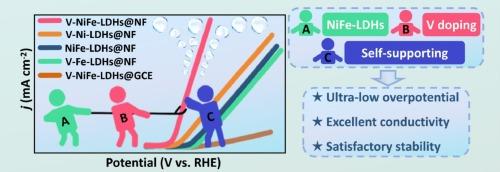电子捕获剂触发高价活性位点驱动电化学尿素辅助制氢。
IF 9.7
1区 化学
Q1 CHEMISTRY, PHYSICAL
引用次数: 0
摘要
尿素氧化反应(UOR)是替代传统析氧反应的一种理想的节能制氢方法。Ni3+被认为是UOR中最活跃的位点。然而,由于氧化能垒高,氧化性强,难以高效稳定地获得充足的Ni3+。针对这一问题,我们在泡沫镍衬底(V-NiFe-LDHs@NF)上合成了一种v掺杂Ni, fe基层状双氢氧化物自支撑电极,其中v诱导的晶格扭曲和电子重排形成并稳定了高价Ni3+活性物质。V-NiFe-LDHs@NF在电流密度为10/100 mA cm-2时,相对于RHE,其UOR催化性能仅为1.253/1.372 V。结构-活性关系研究表明,V作为电子俘获剂可以通过调节活性中心的电子云密度,改变关键中间体*CONH2N与活性位点之间的键合关系,从而避免在复杂环境下高价活性物质因迁移、覆盖或还原而失活。当直接用于尿素辅助制氢时,在100 mA cm-2时,电池电压仅为1.432 V,比传统的水电解低308 mV。本文章由计算机程序翻译,如有差异,请以英文原文为准。

Electron trapping agent triggers high valence active sites driving electrochemical urea-assisted hydrogen production
Urea oxidation reaction (UOR) is an ideal alternative to the traditional oxygen evolution reaction for hydrogen production in energy-saving water electrolysers. Ni3+ has been considered as the most active site in the UOR. However, due to the high oxidation energy barrier and strong oxidizability, it is difficult to obtain sufficient Ni3+ efficiently and steadily. Regarding this issue, we have synthesized a self-supporting electrode of V-doped Ni, Fe-based layered double hydroxides on a nickel foam substrate (V-NiFe-LDHs@NF), where the high-valence Ni3+ active species are formed and stabilized from the V-induced lattice distortion and electronic rearrangement. V-NiFe-LDHs@NF exhibits excellent UOR catalytic performances with only 1.253/1.372 V vs. RHE at the current density of 10/100 mA cm−2, respectively. Structure-activity relationship studies demonstrate that the V as electron trapping agents can change the bond relationship between the key intermediate *CONH2N and the active site by regulating the electron cloud density of the active center, thus avoiding the inactivation of the high valence active species due to migration, covering or reduction in complex environments. When it is directly used in urea-assisted hydrogen production, the cell voltage is only 1.432 V at 100 mA cm−2, lower 308 mV than that of the traditional water electrolysis.
求助全文
通过发布文献求助,成功后即可免费获取论文全文。
去求助
来源期刊
CiteScore
16.10
自引率
7.10%
发文量
2568
审稿时长
2 months
期刊介绍:
The Journal of Colloid and Interface Science publishes original research findings on the fundamental principles of colloid and interface science, as well as innovative applications in various fields. The criteria for publication include impact, quality, novelty, and originality.
Emphasis:
The journal emphasizes fundamental scientific innovation within the following categories:
A.Colloidal Materials and Nanomaterials
B.Soft Colloidal and Self-Assembly Systems
C.Adsorption, Catalysis, and Electrochemistry
D.Interfacial Processes, Capillarity, and Wetting
E.Biomaterials and Nanomedicine
F.Energy Conversion and Storage, and Environmental Technologies

 求助内容:
求助内容: 应助结果提醒方式:
应助结果提醒方式:


